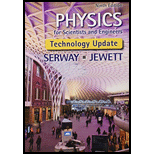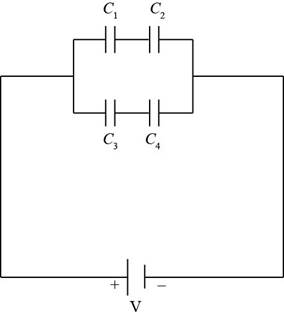
Concept explainers
For (he system of four capacitors shown in Figure P26.19. find (a) the total energy stored in the system and (b) the energy stored by each capacitor, (c) (Compare the sum of the answers in part (b) with your result to part (a) and explain your observation.
(a)
The energy stored in the system.
Answer to Problem 26.56AP
The energy stored in the system is
Explanation of Solution
Given info: The electric potential in the system is
The Figure of the circuit diagram is shown below.

Figure (1)
Since, the capacitors
Here,
Substitute
Thus, the equivalent capacitance of the first row is
Since, the capacitors
Here,
Substitute
Thus, the equivalent capacitance of the second row is
Since, the first and second rows are in parallel to each other. So, the equivalent capacitance of the system is,
Here,
Substitute
Thus, the equivalent capacitance of the system is
Formula to calculate the energy stored in the system is,
Here,
Substitute
Conclusion:
Therefore, the energy stored in the system is
(b)
The energy stored by each capacitor.
Answer to Problem 26.56AP
The energy stored in capacitors
Explanation of Solution
Given info: The electric potential in the system is
Since, the electric potential through each capacitor is same.
Formula to calculate the charge on the first row of capacitor is,
Here,
Substitute
Thus, the charge on the first row of capacitor is
Formula to calculate the energy stored is,
Here,
The energy stored in capacitor
Here,
Substitute
Thus, the energy stored in capacitor
The energy stored in capacitor
Here,
Substitute
Thus, the energy stored in capacitor
Formula to calculate the charge on the first row of capacitor is,
Here,
Substitute
Thus, the charge on the first row of capacitor is
The energy stored in capacitor
Here,
Substitute
Thus, the energy stored in capacitor
The energy stored in capacitor
Here,
Substitute
Thus, the energy stored in capacitor
Conclusion:
Therefore, the energy stored in capacitors
(c)
The comparison of the sum of the energy in part (b) with energy of part (a) and explain it.
Answer to Problem 26.56AP
The sum of the energy of par (b) is same as the energy in part (a).
Explanation of Solution
Given info: The electric potential in the system is
The sum of the energy of the part (b) is,
Substitute
The sum of the energy of par (b) is same as the energy in part (a).
Conclusion:
Therefore, the sum of the energy of par (b) is same as the energy in part (a).
Want to see more full solutions like this?
Chapter 26 Solutions
Bundle: Physics for Scientists and Engineers, Technology Update, 9th Loose-leaf Version + WebAssign Printed Access Card, Multi-Term
- Please solve and answer this problem correctly please. Thank you!!arrow_forwardYou're on an interplanetary mission, in an orbit around the Sun. Suppose you make a maneuver that brings your perihelion in closer to the Sun but leaves your aphelion unchanged. Then you must have Question 2 options: sped up at perihelion sped up at aphelion slowed down at perihelion slowed down at aphelionarrow_forwardThe force of the quadriceps (Fq) and force of the patellar tendon (Fp) is identical (i.e., 1000 N each). In the figure below angle in blue is Θ and the in green is half Θ (i.e., Θ/2). A) Calculate the patellar reaction force (i.e., R resultant vector is the sum of the horizontal component of the quadriceps and patellar tendon force) at the following joint angles: you need to provide a diagram showing the vector and its components for each part. a1) Θ = 160 degrees, a2) Θ = 90 degrees. NOTE: USE ONLY TRIGNOMETRIC FUNCTIONS (SIN/TAN/COS, NO LAW OF COSINES, NO COMPLICATED ALGEBRAIC EQUATIONS OR ANYTHING ELSE, ETC. Question A has 2 parts!arrow_forward
- The force of the quadriceps (Fq) and force of the patellar tendon (Fp) is identical (i.e., 1000 N each). In the figure below angle in blue is Θ and the in green is half Θ (i.e., Θ/2). A) Calculate the patellar reaction force (i.e., R resultant vector is the sum of the horizontal component of the quadriceps and patellar tendon force) at the following joint angles: you need to provide a diagram showing the vector and its components for each part. a1) Θ = 160 degrees, a2) Θ = 90 degrees. NOTE: USE DO NOT USE LAW OF COSINES, NO COMPLICATED ALGEBRAIC EQUATIONS OR ANYTHING ELSE, ETC. Question A has 2 parts!arrow_forwardNo chatgpt pls will upvotearrow_forwardThe force of the quadriceps (Fq) and force of the patellar tendon (Fp) is identical (i.e., 1000 N each). In the figure below angle in blue is Θ and the in green is half Θ (i.e., Θ/2). A) Calculate the patellar reaction force (i.e., R resultant vector is the sum of the horizontal component of the quadriceps and patellar tendon force) at the following joint angles: you need to provide a diagram showing the vector and its components for each part. a1) Θ = 160 degrees, a2) Θ = 90 degrees. NOTE: USE ONLY TRIGNOMETRIC FUNCTIONS (SIN/TAN/COS, NO LAW OF COSINES, NO COMPLICATED ALGEBRAIC EQUATIONS OR ANYTHING ELSE, ETC. Question A has 2 parts!arrow_forward
- ་ The position of a particle is described by r = (300e 0.5t) mm and 0 = (0.3t²) rad, where t is in seconds. Part A Determine the magnitude of the particle's velocity at the instant t = 1.5 s. Express your answer to three significant figures and include the appropriate units. v = Value Submit Request Answer Part B ? Units Determine the magnitude of the particle's acceleration at the instant t = 1.5 s. Express your answer to three significant figures and include the appropriate units. a = Value A ? Unitsarrow_forwardSolve and answer the question correctly please. Thank you!!arrow_forwardSolve and answer the question correctly please. Thank you!!arrow_forward
 Physics for Scientists and Engineers: Foundations...PhysicsISBN:9781133939146Author:Katz, Debora M.Publisher:Cengage Learning
Physics for Scientists and Engineers: Foundations...PhysicsISBN:9781133939146Author:Katz, Debora M.Publisher:Cengage Learning Principles of Physics: A Calculus-Based TextPhysicsISBN:9781133104261Author:Raymond A. Serway, John W. JewettPublisher:Cengage Learning
Principles of Physics: A Calculus-Based TextPhysicsISBN:9781133104261Author:Raymond A. Serway, John W. JewettPublisher:Cengage Learning College PhysicsPhysicsISBN:9781305952300Author:Raymond A. Serway, Chris VuillePublisher:Cengage Learning
College PhysicsPhysicsISBN:9781305952300Author:Raymond A. Serway, Chris VuillePublisher:Cengage Learning College PhysicsPhysicsISBN:9781285737027Author:Raymond A. Serway, Chris VuillePublisher:Cengage Learning
College PhysicsPhysicsISBN:9781285737027Author:Raymond A. Serway, Chris VuillePublisher:Cengage Learning Physics for Scientists and Engineers, Technology ...PhysicsISBN:9781305116399Author:Raymond A. Serway, John W. JewettPublisher:Cengage Learning
Physics for Scientists and Engineers, Technology ...PhysicsISBN:9781305116399Author:Raymond A. Serway, John W. JewettPublisher:Cengage Learning





